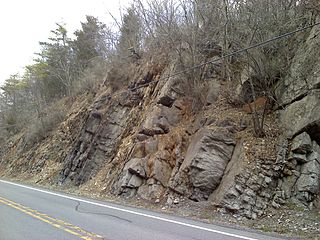Related Research Articles
In the geologic timescale, the Telychian is the age of the Llandovery epoch of the Silurian period of the Paleozoic era of the Phanerozoic eon that is comprehended between 438.5 ± 1.2 Ma and 433.4 ± 0.8 Ma, approximately. The Telychian age succeeds the Aeronian age and precedes the Sheinwoodian age.
In the geological timescale, the Llandovery epoch occurred at the beginning of the Silurian period. The Llandoverian epoch follows the massive Ordovician-Silurian extinction events, which led to a large decrease in biodiversity and an opening up of ecosystems.
The Lau event was the last of three relatively minor mass extinctions during the Silurian period. It had a major effect on the conodont fauna, but barely scathed the graptolites. It coincided with a global low point in sea level, is closely followed by an excursion in geochemical isotopes in the ensuing late Ludfordian faunal stage and a change in depositional regime.

Wills Creek Formation is a mapped Silurian bedrock unit in Pennsylvania, Maryland, Virginia, and West Virginia.
The Mulde event was an anoxic event, and marked the second of three relatively minor mass extinctions during the Silurian period. It coincided with a global drop in sea level, and is closely followed by an excursion in geochemical isotopes. Its onset is synchronous with the deposition of the Fröel formation in Gotland. Perceived extinction in the conodont fauna, however, likely represent a change in the depositional environment of sedimentary sequences rather than a genuine biological extinction.

The Late Silurian to Early Devonian Keyser Formation is a mapped limestone bedrock unit in Pennsylvania, Maryland, Virginia, and West Virginia.
The Kimmswick Limestone is an Ordovician geologic formation in Arkansas, Illinois and Missouri. Fossils occurring in the Kimmswick include corals, bryozoans, brachiopods, conodonts, trilobites, crinoids and mollusks.
The St. Clair Limestone is a geologic formation in Arkansas, Indiana, Missouri, and Oklahoma. It preserves fossils dating back to the Silurian period. This high density, high magnisium dolomitic limestone was originally classified as a marble in Oklahoma due to the fact that it would hold a high polish, hence Marble City.
Cordylodontidae is a family of conodonts.
Edward B. Branson was an American geologist and paleontologist. He worked at the University of Missouri.
Wurmiella is an extinct conodont genus.
Spathognathodontidae is an extinct conodont family ranging from the Silurian to the Devonian.
Ozarkodina is an extinct genus of conodonts in the family Spathognathodontidae.
Carniodus is a conodont genus from the Silurian.
Zieglerodina is an extinct conodont genus in the family Spathognathodontidae.
Anticostiodus is an extinct genus of multielement conodonts. Specimens have been described from the Lower Silurian of Gun River Formation of Anticosti Island, Quebec. Two species are included under the genus, Anticostiodus fahraeusi and Anticostiodus boltoni. Both species occur near the base of the Distomodus staurognathoides zone and in an open subtidal environment.
Distomodus is an extinct genus of conodonts.
Kallidontus is an extinct genus of conodonts.
Pterospathodus is an extinct genus of conodont from the Silurian period.
Prioniodinidae is an extinct family of conodonts in the order Prioniodinida.
References
- ↑ E. B. Branson and M. G. Mehl. 1933. Conodonts from the Bainbridge (Silurian) of Missouri. University of Missouri Studies 8:39-52